
 I’m going against my principle of only writing about books that have been out of print for some time in offering this piece on Paul Metcalf’s Apalache as my contribution to the #1976Club. Although Apalache has been out of print as an individual volume since its publication in 1976, it’s available today as part of Volume I of the Collected Works of Paul Metcalf. On the other hand, that book and its two companion volumes — one of the worthiest products of American independent publishing — came out 25 years ago, so it’s at least no longer new.
I’m going against my principle of only writing about books that have been out of print for some time in offering this piece on Paul Metcalf’s Apalache as my contribution to the #1976Club. Although Apalache has been out of print as an individual volume since its publication in 1976, it’s available today as part of Volume I of the Collected Works of Paul Metcalf. On the other hand, that book and its two companion volumes — one of the worthiest products of American independent publishing — came out 25 years ago, so it’s at least no longer new.
I wanted to write about Apalache because, though his work may be in print, he’s perhaps the most neglected major American writer of the late 20th Century. And he’s certainly the first writer I started to follow devotedly. In looking through my collection of Metcalf’s works — books that have been in storage since 2001, when my wife and I thought we were moving to Europe for just three years — I came across a letter from 1981 in which Metcalf graciously thanked me for what was probably a gushing fan’s note.

Looking at this stack, I also realize that it was assembled at some effort over the course of a decade or more. These books all predate Amazon and online bookshopping. I think I would open my local library’s latest copy of Books in Print, flip to the Ms, and scan to see if there was anything new from Metcalf. Although I found a receipt from Moe’s Books on Telegraph Avenue back in 1982 in Apalache, I’m pretty sure I bought the rest by writing to the publishers and enclosing checks to cover purchase and postage.
Most of Metcalf’s major works — Genoa (1965), Patagoni (1971), The Middle Passage Both (1982) — were published by the Jargon Society, the eclectic independent press run by his friend and Black Mountain College classmate, the poet Jonathan Williams. Williams was not a prolific publisher, but he was a master book designer and meticulous printer and all of the above are beautiful books in their own ways. Apalache was published by the Turtle Island Foundation in Berkeley (certainly why I was able to find it at Moe’s), and though a good-looking piece of work, not quite on the level of the Jargon Society books.
Metcalf put a book designer to the test. His style, at least from Genoa on — constantly draws upon the range of possibilities of then-current typesetting. Metcalf himself always wrote on a manual typewriting, but he never wanted to stay within conventions of font, paragraph, and line. He may have overtaxed the capabilities of Turtle Island’s designer, Clifford Burke. After receiving the manuscript, he called the writer and asked Metcalf to record a reading of the book so that he had a clearer idea of what the writer had in mind.
Apalache weaves together hundreds of excerpts from numerous sources ranging from Native American myths to the journals of early European explorers to scientific texts and newspaper articles. Metcalf’s first book Will West (1956) followed, for the most part, the pattern of a traditional prose narrative. By Genoa, however, his own words began to recede, changing from the substance of the text to the binding agent, the lead in a stained-glass window or the mortar in a mosaic. In his introduction to the 2015 edition of Genoa, novelist Rick Moody described Metcalf’s style as a “helixing of quotation and consciousness, with its multiple fonts and its open-ended grammatical structures, sentences that are sometimes picked up later and sometimes not.”
Metcalf later said that he decided to take a different direction in his writing as he began to work on Genoa in the early 1960s. He was responding, he said, to the sense “that the old-fashioned novel — pure fiction — had played itself out, that it must be refreshed, revivified, by the incontrovertible force of facts.” Those facts, for Metcalf, were the most precious ingredients. He spent months, sometimes years, mining them from countless volumes he found in libraries all over the Northeast. As his friend Guy Davenport once wrote, “Paul Metcalf is a great reader…. Metcalf’s reading is to find things which he puts together in patterns. Such was the working method of Plutarch, Montaigne, Burton, all of whose books are new contexts for other voices.”

Metcalf then pieced these together, sometimes jamming texts into a seamless amalgam, sometimes leaving the original intact, occasionally linking pieces with his own words. From these sections he constructed the overall work based on a design — and an underlying message — that he saw on almost an architectural level. One critic has called Metcalf’s style architectonic, and the link to the geological term tectonic has particular significance in Metcalf’s case. His vision of history in Apalache reaches all the way back to the formation of the features of the North American landscape. The final passages in “Bash-Bish,” the first section of the book, invokes a litany of geologic terms: moraines, drumlins, podzols, eskers, monadnocks. He calls Appalachia the “resistant relic of metamorphosis” (his own words), that metamorphosis being the emergence of the continent from the time when “the earth an ocean. the earth ocean.”
Davenport argued that “Metcalf represents our most radical shift in the form of narrative.” Michael Davidson invented a new term, palimtextual, to describe the kind of work that Metcalf created, in which original source texts formed such an integral part of the overall work’s substance. George Butterick described it as “an eco-system of texts.” And yet there is a familiar literary pattern underlying Apalache: the tragedy.
Apalache is an epic tragedy of the loss of the Eden that North America represented when Europeans began to explore and colonize. In “Bash-Bish,” the first of the eight major sections that comprise Apalache, Metcalf starts with English explorers recounting the fact that they smelled the land before they even saw it. Then, as they land and explore, he moves along with them as they note the lushness and variety of trees, plants, features. And their first encounters with Native Americans and the odd names they give to places: “chaubuqueduck, messatsoosec … twada-alahala … machaquamagansett … the kenogamishish … connoharriegoharriee….”
Then, in “The Feare in Ye Buttocks,” we shift forward to explorations of the interior — the Saint Lawrence, the Great Lakes, the Mississippi — the hardships (starvation, disease, attacks by natives), and the first clashes. He takes the section’s title from the journals of Peter Esprit Radisson, recalling the desperation that set in on long excursions by canoe into what are now parts of Quebec and Ontario:
A strange thing when victualls are wanting, worke whole nights and dayes, lye down on the bare ground and not allwayes that hap, the breech in the water, the feare in ye buttocks, to have the belly empty, the weariness in the bones and drowsiness of ye body by the bad weather that you are to suffer, having nothing to keep you from such calamity.
The dramatic mid-point of the narrative comes in section three, “South →.” Metcalf assembles an abbreviated account of Roger Williams, banished from the Massachusetts Bay Colony and forced to head south to what is now Rhode Island, where he founds the Providence Plantations. Williams encouraged a spirit of cooperation and co-habitation with the native Narragansett people that contrasts with the attitudes of the Massachusetts Puritans — and represented, for Metcalf, the one chance America had of a common stewardship of the land.
Unfortunately, as today’s American historians are demonstrating with increasing effectiveness (and controversy), much of this land’s history is colored by discrimination, hatred, exploitation, and violence. The next few sections offer depressing examples. In “Telemaque,” Metcalf runs parallel narratives — literally — of Denmark Vesey, a freed slave who attempted to organize an armed takeover of Charleston, South Carolina in 1822; and of Robert Williams, a North Carolina organizer who argued for the right of blacks to defend themselves against white violence with weapons, if necessary. Betrayed by one of his fellow conspirators, Vesey was hanged along with five other men. Railroaded in his hometown of Monroe, Williams eventually fled to Cuba, and later China, before returning to the US in 1970. The charges against him were dropped soon after he appeared at the Monroe courthouse.

The most damning passage, however, is in the section titled “Okefenokee.” Metcalf gives us a snatch of the genealogy of the Thrifts, a family that settled near the Georgia swamp, then howls across the following pages in large print, one word per page:
Hard Thrift logged the trembling earth.
Section six, “Shick Shock,” reconstructs America’s Genesis. “Where the sun sleeps, our fathers came thence.” Metcalf traces, using a combination of scientific/archaeological accounts, excerpts from Creek, Delaware, Iroquois, and other Native American myths, and passages from the Vinland Saga and the journal of Arthur Barlowe, Sir Walter Raleigh’s co-captain on the first Roanoke expedition, how the two peoples came into the land. How they came into contact he saves for the final two sections, “Cocoanut Indians” and “Beothuk.”
The last takes its name from the natives encountered by Sebastian Cabot and the first white settlers of Newfoundland. The Beothuk are probably responsible for the stereotype of the “red Indian,” as they had the habit of coloring their faces with red ochre pigment. Small in number, the Beothuk were considered “ghost people” by other tribes for their ability to disappear into the woods. This skill was not enough, however, to protect them from the white hunters and fishermen, who not only tended to shoot them on sight but then to brag of such acts as if of great accomplishments.
Despite the fact that consecutive colony governors banned such killings as “inhuman barbarity,” the practice continued. By 1770, Captain George Cartwright, whose report Metcalf quotes, wrote grimly,
It will be expected by the British reader that a work on Newfoundland should afford some insight into the destiny of the Beothuk Indian; but I am sorry to say, I cannot satisfy this expectation; none have been seen of late even by the trappers and hunters, by the Micmaics, or by the Esquimaux of Labrador; and, unless they are in the fastnesses of the centre of the island, the race has emigrated, or become extinct.
Metcalf closes with a phrase from one of the origin myths he used in “Shick Shock”: “… they feared a powerful monster, who was to appear from the sea.”

Metcalf never used a computer. Reading Apalache, I took generous advantage of the capabilities of search engines to track down passages in the book to their source texts. The text contents search feature of the Internet Archive was a particularly useful tool. One benefit of these searches was to see the quoted passages in context. In many cases, reading the longer text from which Metcalf took a few sentences, or even just a phrase, amplified the power of Metcalf’s mosaic. It gave me a chance to see the work, if you will, though Metcalf’s eyes, to understand what he chose to include and what to leave out. If ever Apalache gets the serious annotation it deserves, I think more readers will be able to see this book for the American classic I think it is.
In a eulogy he published in Rain Taxi, Allan Kornblum wrote that Paul Metcalf had “a scope of historical vision and a depth of compassion that I found breathtaking.” I find that last phrase key to appreciating Metcalf’s work. Yes, it is densely historical, and as he said himself, full of “the incontrovertible force of facts.”
But those who knew the man are uniform in their praise of his generosity, curiosity, and gentleness. Metcalf and his wife Nancy spent most of their lives in a secluded piece of land outside Pittsfield, Massachusetts, living in a rough wooden house with few conveniences. Day after day, when he wasn’t in a library, Metcalf retired to a small cabin on the property where he worked on his books. He was, in some ways, a more authentic Thoreau than Henry David himself, who relied on his mother to bring him supplies during his year of seclusion at Walden Pond.
With all my searching for the sources in Apalache, what I ultimately took away from the book was a deep sense of sadness. It is, in its unique way, the Great American Novel — if you accept that the Great American story is that of the destruction of Eden and its inhabitants and their replacement by a spirit of exploitation enforced through violence. I defy anyone to read “Beothuk” and not feel that you’re leaving part of your heart behind.
Metcalf once told Dalkey Archives founder John O’Brien that his daughter — who rarely read her father’s work — came to him after finishing Apalache and said, “I’ve learned something: you’re a closet romantic.” “Do you know what this book is?” she teased him. “No, what is it?” he replied. “It’s a love poem,” she answered. “You’re in love with North America.” Yet it’s love poem free of all illusions about the beloved. Metcalf looks upon the continent with wonder at its beauty and power — and horror at the crimes to be witnessed wherever one looks in its history.
Forty years ago, I was a noisy and enthusiastic young fan of Paul Metcalf’s work. Now, I am simply in quiet awe.








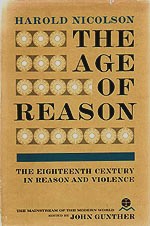 The Age of Reason was the first of a half-dozen or so books in a series published by Doubleday in the early 1960s. Edited by the veteran reporter John Gunther, author of the popular “Inside” books of the 1940s and 1950s, the series had the impressive title of “The Mainstream of the Modern World.” Although works of history, the books were all written by authors better known for fiction (Alec Waugh), reportage (Edmond Taylor), or miscellany (Nicolson), and all focused more on personalities than movements, politics, and larger issues.
The Age of Reason was the first of a half-dozen or so books in a series published by Doubleday in the early 1960s. Edited by the veteran reporter John Gunther, author of the popular “Inside” books of the 1940s and 1950s, the series had the impressive title of “The Mainstream of the Modern World.” Although works of history, the books were all written by authors better known for fiction (Alec Waugh), reportage (Edmond Taylor), or miscellany (Nicolson), and all focused more on personalities than movements, politics, and larger issues.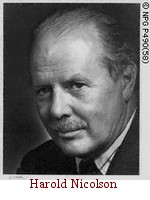
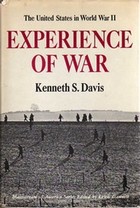 A very long time ago, I checked a book titled
A very long time ago, I checked a book titled 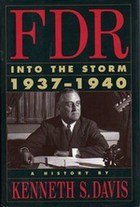 Despite the fact that Random House gave the fourth volume,
Despite the fact that Random House gave the fourth volume, 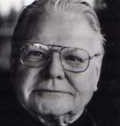 So is that the fate of Kenneth S. Davis? To have steadily and diligently written himself into oblivion? At the moment, all but his history of
So is that the fate of Kenneth S. Davis? To have steadily and diligently written himself into oblivion? At the moment, all but his history of 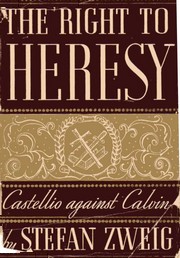
 That winter, the old General moved from the rooms he had rented from the free mulatto, Wormley, in I Street to Cruchet’s at Sixth and D Streets. His new quarters, situated on the ground floor–a spacious bedroom, with a private dining-room adjoining–were convenient for a man who walked slowly and with pain; and Cruchet, a French caterer, was one of the best cooks in Washington.
That winter, the old General moved from the rooms he had rented from the free mulatto, Wormley, in I Street to Cruchet’s at Sixth and D Streets. His new quarters, situated on the ground floor–a spacious bedroom, with a private dining-room adjoining–were convenient for a man who walked slowly and with pain; and Cruchet, a French caterer, was one of the best cooks in Washington.
 “This,” Australian historian Geoffrey Blainey writes in his preface, “as an attempt to write a world history that is not too voluminous. It tries to survey history since the time when the first people left Africa to settle the globe. Inevitably, some large themes which I investigated are described so fleetingly that they are like glimpses from the window of a passing train.”
“This,” Australian historian Geoffrey Blainey writes in his preface, “as an attempt to write a world history that is not too voluminous. It tries to survey history since the time when the first people left Africa to settle the globe. Inevitably, some large themes which I investigated are described so fleetingly that they are like glimpses from the window of a passing train.”